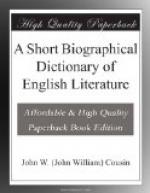KAVANAGH, JULIA (1824-1877).—Novelist, dau. of Morgan K., poet, and philologist, wrote many novels, of which the scene is usually in France, among which are Madeleine (1848), Adele, and Daisy Burns; also biographical works, Woman in France in the 18th Century (1850), etc.
KAYE, SIR JOHN WILLIAM (1814-1876).—Historian and biographer, s. of a London solicitor, was ed. at Eton and Addiscombe. After serving for some time in the Bengal Artillery, he succeeded J.S. Mill as sec. to the political and secret department in the East India Office. His first literary work was a novel pub. in 1845, and he then began his valuable series of histories and biographies illustrative of the British occupation of India, including The War in Afghanistan (1851), and The Sepoy War in India, which he did not live to finish, and which was completed by G.B. Malleson as The History of the Indian Mutiny (6 vols., 1890); also histories of the East India Company and of Christianity in India, and Lives of Sir John Malcolm and other Indian soldiers and statesmen. All his writings are characterised by painstaking research, love of truth, and a style suited to the importance of his subjects. He was made K.C.S.I. in 1871.
KEARY, ANNIE (1825-1879).—Novelist, wrote some good novels, including Castle Daly, A Doubting Heart, and Oldbury, also books for children and educational works.
KEATS, JOHN (1795-1821).—Poet, s. of the chief servant at an inn in London, who m. his master’s dau., and d. a man of some substance. He was sent to a school at Enfield, and having meanwhile become an orphan, was in 1810 apprenticed to a surgeon at Edmonton. In 1815 he went to London to walk the hospitals. He was not, however, at all enthusiastic in his profession, and having become acquainted with Leigh Hunt, Hazlitt, Shelley, and others, he gave himself more and more to literature. His first work—some sonnets—appeared in Hunt’s Examiner, and his first book, Poems, came out in 1817. This book, while containing much that gave little promise of what was to come, was not without touches of beauty and music, but it fell quite flat, finding few readers beyond his immediate circle. Endymion, begun during a visit to the Isle of Wight, appeared in 1818, and was savagely attacked in Blackwood and the Quarterly Review. These attacks, though naturally giving pain to the poet, were not, as was alleged at the time, the cause of his health breaking down, as he was possessed of considerable confidence in his own powers, and his claim to immortality as a poet. Symptoms of hereditary consumption, however, began to show themselves and, in the hope of restored health, he made a tour in the Lakes and Scotland, from which he returned to London none the better. The death soon after of his brother Thomas,




